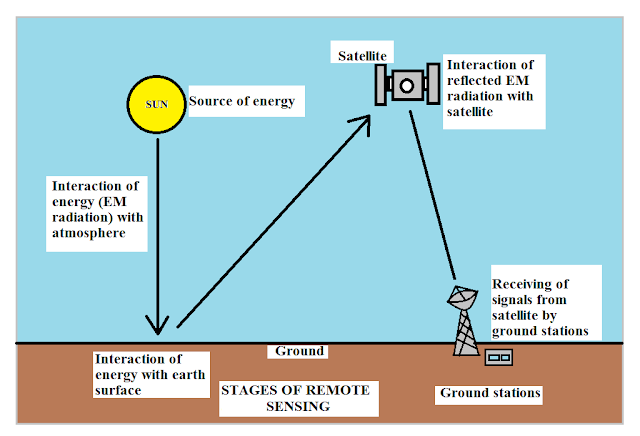What is Remote Sensing?
"Remote detecting is the science (and somewhat, specialty) of gaining data about the Earth's surface without really being in contact with it. This is finished by detecting and recording reflected or transmitted Energy what's more, handling, breaking down, and applying that data."
“Remote sensing is defined as the science and art of obtaining information about an object, area, or phenomenon through the analyses of data acquired by the sensor that is not in direct contact with the target of investigation” (Schultz and Engman, 2000; Ritchie and Rango, 1996).
 |
| Electromagnetic Sprectrum (source:Nirupama and Simonovic 2002) |
Remote Sensing is characterized as the science and innovation by which the qualities of objects of intrigue can be recognized, estimated or broke down the attributes without direct contact. This should be possible by the utilization of either recording or ongoing detecting device(s) mounted on airplane, shuttle, satellite, float, or boat.
The specialized term "remote sensing" was first utilized in the United States in the 1960's, and incorporated photogrammetry, photograph translation, photograph geography and so on. Since Landsat-1, the principal earth perception satellite was propelled in 1972, remote detecting has gotten broadly utilized.
Remote sensing empowers us to obtain data about a object, item or surface while at a good ways from it. Something beyond a wellspring of satisfying pictures, these refined procedures presently permit researchers to comprehend the Earth in manners we at no other time envisioned.
 |
| Figure : Different stages in Remote sensing and data acquisition (Source: Nirupama and Simonovic 2002) |
From 1960 onwards, since the start of spaceflight, a regularly developing body of data is being accumulated utilizing space-based remote Sensing.
Farming, meteorology, oceanography, biology, cartography, organic science, geomorphology and topography are only a couple of the orders which have been changed by this innovation. Some of the most significant natural issues within recent memory are just getting comprehended as a result of tremendous systems of remote detecting gadgets and information investigation frameworks.
In quite a bit of remote detecting, the procedure includes a collaboration between occurrence radiation and the objectives of intrigue. This is exemplified by the utilization of imaging frameworks where the accompanying seven components are included. Note, anyway that remote detecting additionally includes the detecting of radiated vitality and the utilization of non-imaging sensors.
1. Energy Source or Illumination- the principal prerequisite for remote detecting is to have a energy source which enlightens or gives electromagnetic energy to the objective of intrigue.
2. Radiation and the Atmosphere- as the energy ventures out from its source to the objective, it will interact with and communicate with the environment it goes through. This connection may happen a second time as the vitality ventures out from the objective to the sensor.
3. Connection with the Target - when the energy advances toward the objective through the environment, it interfaces with the objective relying upon the properties of both the objective and the radiation.
4. Recording of Energy by the Sensor - after the vitality has been dissipated by, or produced from the objective, we require a sensor (remote - not in contact with the objective) to gather and record the electromagnetic radiation.
5. Transmission, Reception, and Processing - the energy recorded by the sensor must be transmitted, regularly in electronic structure, to a getting and handling station where the information are prepared into a picture (printed copy as well as computerized).
 |
| Figure : Different stages in Remote sensing and data acquisition (Source: http://www.ansp.org/museum/kye/tech_environment/2001_remote_sensing.php) |
6. Translation and Analysis - the prepared picture is deciphered, outwardly and additionally carefully or electronically, to separate data about the objective which was lit up.
7. Application - the last component of the remote detecting process is accomplished when we apply the data we have had the option to remove from the symbolism about the objective so as to more readily get it, uncover some new data, or help with taking care of a specific issue.
These seven components contain the remote detecting process from start to finish.
References:
References:
- https://www.nrcan.gc.ca/maps-tools-publications/satellite-imagery-air-photos/remote-sensing-tutorials/fundamentals-remote-sensing-introduction/9363
- https://www.ldeo.columbia.edu/res/fac/rsvlab/fundamentals_e.pdf
- https://www.usna.edu/Users/oceano/pguth/md_help/html/satb4dv6.htm
- https://www.seos-project.eu/remotesensing/remotesensing-c00-p02.html
- https://shodhganga.inflibnet.ac.in/bitstream/10603/30500/7/07_chapter3.pdf
- https://learnwithsoham.blogspot.com/2018/09/stages-of-remote-sensing.html
- http://www.gdmc.nl/oosterom/PoRSHyperlinked.pdf
- https://www.researchgate.net/publication/209804877_Role_of_remote_sensing_in_disaster_management/citations



No comments:
Post a Comment